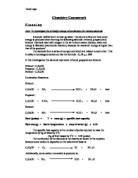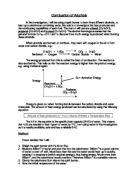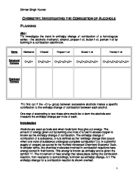I can find out how much energy is given off by using an equation. By knowing the temperature rise of the water, its volume and specific heat capacity of the water, I can calculate the energy released.
Equation:
Change in enthalpy (Q) = mTs
M = mass of water ( g )
S = Specific heat capacity of water ( 4.2 J/oC /g )
T = Change in temperature of water ( oC )
Then by dividing this by the number of moles given off I can work out the kj/mol of energy released. I can then calculate the actual amount from secondary sources and thus find out how efficient the experiment is and how much energy is released in this reaction.
Method
To do this experiment I will need to measure:
- The starting temperature
- The end temperature
- The increase in temperature
- The amount of alcohol before and after the experiment
- The time it takes for the reaction to ‘complete’
I will need the following apparatus :
1. Measuring cylinder, to measure 200ml of water. This is accurate to about 1 ml.
2. A thermometer, to measure temperature of the water before, and after combustion, with to about 1oC
3. A stop clock, to measure how long it takes to increase 30oc. Accuracy: to about .1 second (depending on reaction time)
4. A beaker, to contain the heated water
5. Spirit burner, 3 burners each containing a different alcohol:
Ethanol
Propan1ol
Butan1ol
6. Chemical balance to measure the mass of fuel before and after combustion. Accuracy to about 0.01g.
7. Heat proof mat, clamp and stand for the reaction to take place on.
8. Draft ‘breakers’ to insulate the experiment.
9. A glass rod to stir the experiment.
I will repeat each alcohol three times.
Diagram:
I will set up the experiment like this:
I will use the spirit burner to burn the alcohols in. I will use the clamp and retort stand to hold it into place. Then I will put the burner beneath it and light the alcohol. The Alcohol will have been measured before the experiment, in the spirit burner. I will have to measure the burner with the cap on because the chemicals involved are volatile and would evaporate otherwise. I will use cardboard draft breakers around the clamp, but they must be sufficiently far away from the cardboard in case they catch fire. I will start the timer, light the alcohol beneath the beaker and see how long it takes to increase 30oC. This is because if it is heated up much more the heat loss and inefficiently become sufficient to have a serious effect on the results, because they will be loosing energy faster than they would at lower temperatures.
Safety
1. Wear safety glasses, if burning alcohols were to somehow get into an eye the victim could be blinded.
2. Avoid any naked flame near alcohol being stored or measured.
3. Clean up any alcohol spills immediately.
4. Take care not to handle hot apparatus, allow to cool before dismantling and cleaning.
5. Make sure the fire is out before putting the lid on the spirit burner because if it isn’t the spirit burner could explode from the pressure and cause serious injury.
6. Wear a lab coat and keep ties behind the coat so clothes cannot be set on fire by spilt alcohols.
Variables to control, and fair test.
1. Position of OH group in alcohol molecule. Propanol and Butanol are long enough carbon chains to form isomers (same chemical formula but different structural formula) the -OH group needs to be on the end Carbon atom in the alcohols tested. Secondary information indicates that the bond energies between two atoms will vary according to where in the molecule the pair of atoms is. For this reason propan-1-ol and butan-1-ol are used so all molecules used will have the -OH group on the end Carbon atom.
2. Height of beaker above the wick will be kept to roughly .75cm in every case.
3. The volume of water used each time will be 200 ml (= 200g mass). The calculation does take into account the mass of water, but for comparison it should be constant if possible to ease calculation.
4. The temperature of the water should be low to start and for convenience distilled water is used at as close to room temperature as it is. If the start temperature is too high the water might boil and would not show any further temperature increase even though energy is still released.
5. The same beaker will be used each time and it will be cleaned after each experiment.
6. Height of flame, this will depend on the length of exposed wick, this will be kept constant at 1 cm.
7. Each alcohol will be combusted three times so anomalies can be left out and identified.
8.The set up will be kept the same for each alcohol.
9. The spirit burners will be as identical as possible.
10. Stir the water constantly to keep the temperature universal.
Calculating and predicting results
Prediction.
I predict that the higher the mass of the molecule then the higher the amount of energy given off. This is because there are more bonds to make and break, thus increasing the values involved. For example, you get more bonds made when you burn Butan1ol than when you burn ethanol:
Adding each extra H-C-H to the molecule gives a theoretical 824 kJ/mole needed to beak them, but I know that the experiment is exothermic so the extra bonds will result in more energy given off. This gives a straight line graph. I will need to see if my results support this predicted constant increase in energy released.
I also predict that the more the bonds the more efficient the reaction, this is because more energy will be released and the product will heat up quicker.
I think this is a good way to do this reaction. I have used this set up before when I determined the enthalpy of combustion of some alcohols.
Calculations
By using the average bond energy values from calculations for GCSE chemistry I can predict the energies given off from burning the alchohols. I will use Enthalpy cycles to show this.
Molecular formula:
C2H5OH + 3O2 2CO2 + 3H2O
Structural formula:
Ethanol.
Break: Five C-H bonds 5 x 412 2060
Three O=O bonds 3 x 498 1494
One C-C bond 348 348
One C-O bond 360 360
One O-H bond 463 463
Total 4725 kj /mol used
Make Four C=O bonds 4 x 743 2972
Six H-O bonds 6 x 463 2778
Total 5750 kj /mol given out
Enthalpy = 4725 – 5750 = -1025 kj/mol used.
Propan1ol.
2 C3H7OH + 9O2 6CO2 + 8H2O
Break: 14 C-H bonds 14 x 412 5768
9 O=O bonds 9 x 498 4482
4 C-C bond 4 x 348 1392
2 C-O bond 2 x 360 720
2 O-H bond 2 x 463 926
Total 13288 kj /mol used
Make
12 C=O bonds 12 x 743 8916
16 H-O bonds 16 x 463 7408
Total 16324 kj /mol given out
Enthalpy = 0.5(13288 -16324) = -1518 kj/mol used.
Butan1ol
Break: 9 C-H bonds 9 x 412 3708
6 O=O bonds 6 x 498 2988
3 C-C bond 3 x 348 1044
One C-O bond 360 360
One O-H bond 463 463
Total 8563 kj /mol used
Make
8 C=O bonds 8 x 743 5944
10 H-O bonds 10 x 463 4630
Total 10574 kj /mol given out
Enthalpy = 8563 – 10574 = -2011 kj/mol used.
Predicted graph: (attached)
Obtaining Evidence
The experiment went as planned. There were some anomalies where I made a mistake during the procedure (like putting on the draft shields or forgetting to start the clock). I omitted these because they were anomalies due to my fault.
See Table attached.
Analysis
See Graphs attached.
Patterns in the results:
The energy released from a mole of alcohol increases with increased molecular mass. The graph, clearly shows a rising line for energy release with increased numbers of carbon atoms per molecule. The number and range of results is enough to support my conclusions. The energy increases because the more atoms the more bonds there are, because in the type of reaction for the series, the reactants loose energy, then the more bonds there are to start with the more are broken and made, leaving more energy given off so there is proportionately more exothermic energy released. This is due to the reaction gaining another ‘sub reaction’. Each extra carbon atom needs two hydrogen atoms and 3 oxygen atoms:
CH2 + 1.5 O2 CO2 + H2O
This is exothermic, so the more carbon molecules the more exothermic the reaction, proportionally.
Initially the efficiency decreased as the no of carbon molecules went up. However this was not fully supported because the butan1ol results were more or less as efficient as the propan1ol results. However I saw that the flames for those experiments were more yellow, meaning that carbon was burning and that CO gas was also burning. Also the beakers had soot (carbon) on the bottom of them at the end of the experiment, this would have decreased the efficiency. This has changed my results because the increase in energy release between each alcohol was supposed to be a constant value. The graph shows that this prediction did not show in the results. The value for Propanol I think is anomalous and the culprit of this. If it followed the efficiency trend and was more efficient then the results would have been clearer.
Comparison to prediction.
I think that the main reason that the conclusion did not fit the conclusion is the inefficiency of the method. I did not predict the inefficiency of the experiment like this; in fact, I predicted the opposite. I predicted that the reaction would be more efficient, but it wasn’t. I did not expect this. The reasons for inefficiency are in the evaluation and previously in the conclusion. The method was too inefficient to give good enough results.
Evaluation
In theory the experiment is a good way of finding out the enthalpy of alcohols, but in practice it is to inefficient. The experiment went well because there were no major problems and the results were quite accurate. The experimental method was flawed in that the results are too inaccurate due to heat loss and unwanted heat gain. The results were accurate enough to see some trends but in some cases to inconclusive to be used as hard evidence. If I did the experiment again I would revise my method. The inefficiency caused to many inaccuracies and anomalies. For example the third butan1ol experiment and the whole propan1ol range being too inefficient.
Inefficiencies could be due to the following factors:
1. The energy used in making the product gases expand is ignored. When the experiment occurs, the product gasses given off absorb some heat and expand away from the reaction.
2. The energy output in light energy is not measured, this is a significant amount of energy.
3. The bond energy depends on the other elements and bonds in the molecule. E.g. C-O bond in methanol H= 360 kJ/mol but the C-O bond has an average value of H = 412kJ/mol.
4. The calculated bond energies only account for bond breaking and making within molecules. They do not account for van der valls attractions broken and made between molecules. The calculations assume all substances are gas and the vaporisation energy to convert liquid methanol (l) to gas methanol (g) is ignored.
5. Energy given off and conducted through air was lost and unaccounted for, decreasing the value.
6. The beaker absorbs a lot of heat energy and keeps it, decreasing the amount of energy involved.
7. At higher temperatures heat is lost quicker so the temperature decreases.
8. Incomplete combustion decreases the energy given off, the amount of incomplete combustion increases due to the lack of oxygen in the reaction area and the longer the chains of molecules the more oxygen needed. So the larger the molecule the more incomplete combustion there is.
9. The water evaporated so there was less to heat, increasing the reading.
10. heat could have been lost to the clamp system.
If I now allow for errors in measuring heat output due to limitations of the apparatus and technique, I can see why my predictions are not strictly accurate in numerical terms.
My prediction was based on the fact that as more bonds are broken then remade with increasing alcohol molecule size then the more energy is released in the exothermic reaction. y overall prediction for this pattern of results is still valid so my results do support my prediction. The differences between alcohols in my investigation results do not show the predicted constant value.
I could solve these problems by using a calorimeter which retains all substances inside a water jacket; to absorb all the energy produced.
A bomb calorimeter.
NB a calorimerter like this could be used to burn a specific amount of feul and the oxygen needed could be delivered via a tube.
Also, rather than a measuring cylinder, I would choose to use a more accurate pipette, like we used for titration investigations. This will improve accuracy from 1 ml to 0.1 ml. I would use an extended range of alcohols, including Pentanol, hexanol, heptanol, octanol and decanol and methanol. The predicted and observed trend of increasing exothermic energy should continue with this series. Also I would use something other than spirit burners, with the alcohol at room temperature. I would have (if possible) an electic calorimeter which stirs, times and measures the temperature simultaneously.
The effect of bond position can be investigated by using a range of isomers, e.g. butan-1-ol, butan-2-ol and butan-3-ol. These would show the differences in exothermic energy depending on the structure of the isomer. I am not sure how this would effect the experiment. According to chemistry in context the isomer means that there are different numbers of certain bonds, thus effecting the combustion. Also pressure could be investigated to see if the gasses burn better when in pressure. Other homologous series’ could be investigated and their combustion compared to that of alcohols. They could be burnt the same way as this experiment (with the adjustments mentioned in the evaluation).








